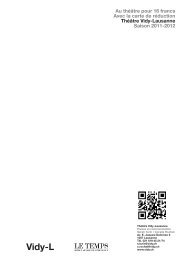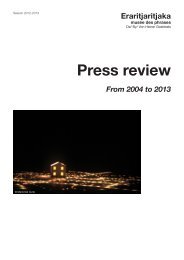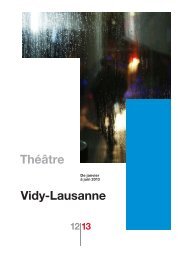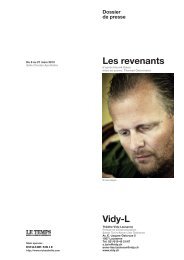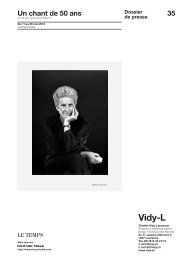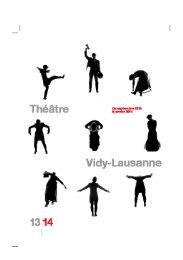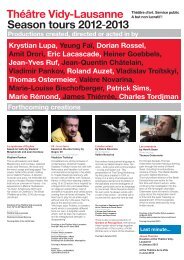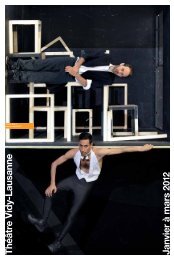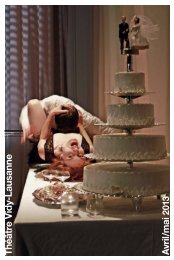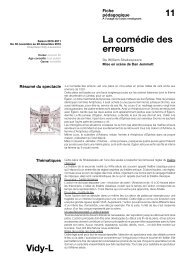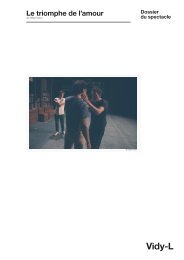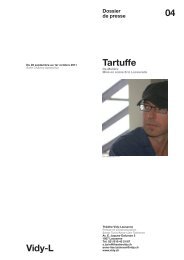Hashirigaki - Théâtre Vidy Lausanne
Hashirigaki - Théâtre Vidy Lausanne
Hashirigaki - Théâtre Vidy Lausanne
- No tags were found...
Create successful ePaper yourself
Turn your PDF publications into a flip-book with our unique Google optimized e-Paper software.
Saison 2011-2012<strong>Hashirigaki</strong>De/ By/ Von Heiner GoebbelsVillage Voice (EN)23.03.2003From Ear to Eternity<strong>Hashirigaki</strong> by Heiner GoebbelsThe title of Heiner Goebbels’s musictheaterpiece, <strong>Hashirigaki</strong>, refers to aJapanese word for flowing, scriptedwriting. And like a pen rolling with effluenceover paper, his production glidesforward in fluid motion, celebrating flux.Each scene in this series of extendedmusical tableaux contains some movingcur-rent: Thick wavering lines projectacross the space, objects descend andswing overhead, performers sway backand forth or tread toward never founddestinations. The stream of words andsound rarely abates, carrying one set ofrhythms and images into the next. Evenwhen contrasting elements abruptly collide,they quickly become re-absorbedinto the production’s sumptuous textures.Goebbels, a leading composer-directorin Europe, explores relationshipsof image, sound, and text in this presentationby Theatre <strong>Vidy</strong>-<strong>Lausanne</strong> atBAM. But unlike a lot of cross-disciplinaryperformance today- - which oftenresists accrued meaning or refuses toallow fragmented components to addup - Goebbels’s work cultivates connectionsand looks for sensory and experientialdepth. His compositions embodythe fluctuations of con-sciousness, atall its speeds and in all its tones. Wewatch three versatile women (CharlotteEngelkes, Marie Goyette, and YumikoTanaka) of different heights and nationalities(Swedish, French Canadian, Japanese)perform his soundscapes; theyrange from traditional Japanese folk arrangementsfor the koto and samisen, tothe theremin’s «pure» tones, to samplesof Brian Wilson’s bouncy instru-mentalsfor Pet Sounds (the 1966 Beach Boysalbum). Relishing their various accentsfor hu-mor and charm, the women alsorecite selected passages from GertrudeStein’s The Making of Americans a modernistepic describing the human family’sevolution over time.Building on Stein’s always mutating language,Goebbels passes from entrancingpercussion with finger cymbals toa harmonium solo to giddy pop. Ratherthan choreographing with the mechanizedrigidity of, say, Robert Wilson- another director devoted to Stein’sformal rigors - Goebbels allows his perform-ersa degree of natural poise asthey propel themselves through successiveworlds. But the visual connectionsremain precise: A woman perceives ashadow cast on an up-stage screen andtries to align herself with it as it swellsinto a balloon and then morphs into aheadless woman. After another dancein which the women sway in conicalhoopskirts, three bells descend from thesky on ropes, mirroring the performers’physiques and creating a new set ofpossibilities.The environment seems always to be coalescinginto something greater or morecomplete. At <strong>Hashirigaki</strong>’s delightful zenith,Wilson’s «God Only Knows» vampsbrightly as the women drag cardboardcutouts onstage; they create a little citymoving in silhouette with skyscrapers,church steeples, buses, and houses withlaundry lines. «Noise, continued noise,much noise,” they exclaim, «somethingsomeone is not hearing!” With such richevocations of the world´s spectrum ofnoise, Goebbels makes listening to itpure pleasure, <strong>Hashirigaki</strong> revels in theomnipotent noise of consciousness;Compress Your Dreams, a short musicalpiece by Transmission Projects, is asearch for silence. A large, glossy whiteplatform, sloped at the edges, stands inthe Gale Gates gallery’s center: a psychologicaltundra of ice and isolation.As the audience drifts in, a namelessyoung woman (played by the expressiveOkwui Okpokwasili) gazes acrossthe lonely expanse to the looped soundsof howling winds, which might also beheard as deep breaths. Inner and outerlandscapes overlap more thoroughlywhen her doppelgänger (Anika TromholtKristensen) appears moments later,prompting self-interrogation throughdialogue, songs, and mirroring-movementsequences.Identically dressed in furlike coats,boots, and bucket-shaped hats, thewomen (or woman) inhabit their arcticenvironment as naturally as polar bears -and if polar bears could sing, they mightvery well produce the gentle croons ofcomposer-performer Cynthia Hopkins.Her sound design provides the dreamierparts of the work’s title; she weavesfeedback, speech samples from a liveradio, digitally delayed loops of stringand bow, and keyboard pulses intosuggestive, resonant lay-ers. Her voiceoversare full of understated introspection,and her songs bring to mind PattiSmith with their musing fantasias - especiallyin the haunting final lyric for acousticguitar («A madman is a dreamer w hodoesn’t sleep»).The abundance of musical monologues,ironically, fuels the protagonist’sanguish. If Goebbels shows us ecstaticfigures reveling in the sonic boom of



